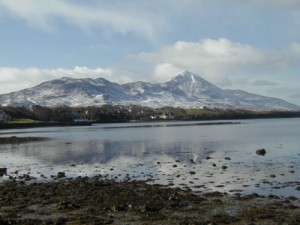St. Patrick continued until his death to visit and watch over the churches which he had founded in all the provinces in Ireland. He comforted the faithful in their difficulties, strengthened them in the Faith and in the practice of virtue, and appointed pastors to continue his work among them. It is recorded in his Life that he consecrated no fewer than 350 bishops. He appointed St. Loman to Trim, which rivaled Armaugh itself in its abundant harvest of piety. St. Guasach, son of his former master, Milchu, became Bishop of Granard, while the two daughters of the same pagan chieftain founded close by, at Clonbroney, a convent of pious virgins, and merited the aureola of sanctity. St. Mel, nephew of our apostle, had the charge of Ardagh; St. MacCarthem, who appears to have been particularly loved by St. Patrick, was made Bishop of Clogher.
The narrative in the ancient Life of the saint regarding his visit to the district of Costello, in the County of Mayo, serves to illustrate his manner of dealing with the chieftains. He found, it says, the chief, Ernasc, and his son, Loarn, sitting under a tree, “with whom he remained, together with his twelve companions, for a week, and they received from him the doctrine of salvation with attentive ear and mind. Meanwhile he instructed Loarn in the rudiments of learning and piety.” A church was erected there, and, in after years, Loarn was appointed to its charge.
The manifold virtues by which the early saints were distinguished shone forth in all their perfection in the life of St. Patrick. When not engaged in the work of the sacred ministry, his whole time was spent in prayer. Many times in the day he armed himself with the sign of the Cross. He never relaxed his penitential exercises. Clothed in a rough hair-shirt, he made the hard rock his bed. His disinterestedness is specially commemorated.
Countless coverts of high rank would cast their precious ornaments at his feet, but all were restored to them. He had not come to Erin in search of material wealth, but to enrich her with the priceless treasures of the Catholic Faith. From time to time he withdrew from the spiritual duties of his apostolate to devote himself wholly to prayer and penance.
One of his chosen places of solitude and retreat was the island of Lough Derg, which, to our own day, has continued to be a favorite resort of pilgrims, and it is known as St. Patrick’s Purgatory. Another theatre of his miraculous power and piety and penitential austerities in the west of Ireland merits particular attention. In the far west of Connaught there is a range of tall mountains, which, arrayed in rugged majesty, bid defiance to the waves and storms of the Atlantic. At the head of this range arises a stately cone in solitary grandeur, about 4000 feet in height, facing Crew Bay, and casting its shadow over the adjoining districts of Aghagower and Westport.

Croagh Patrick, or St. Patrick’s Mountain
This mountain was known in pagan times as the Eagle Mountain, but ever since Ireland was enlightened with the light of Faith it is known as Croagh Patrick, or St. Patrick’s mountain, and is honored as the Holy Hill, the Mount Sinai, of Ireland. St. Patrick, in obedience to his guardian angel, made this mountain his hallowed place of retreat. In imitation of the great Jewish legislator on Sinai, he spent forty days on its summit in fasting and prayer, and other penitential exercises. His only shelter from the fury of the elements, the wind and rain, the hail and snow, was a cave, or recess, in the solid rock; and the flagstone on which he rested his weary limbs at night is still pointed out.
